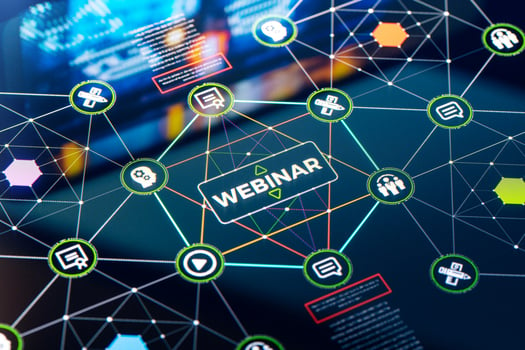
In 2020, the practice of hosting a webinar became more popular and, in the right hands, effective. B2B companies have learned that webinars are great for generating new leads for every stage of the sales funnel.
Many B2B companies and manufacturers are already taking advantage and using webinars as a part of their content marketing strategy. However, similar to all marketing efforts, webinars are only as effective as your planning and execution allows them to be.
Below we’ve provided a checklist for hosting a webinar, along with some common webinar mistakes you should avoid.
Checklist for Hosting a Webinar
This checklist is broken down into three sections: Planning/strategizing, preparing/promoting, and executing/follow-up. In reality, the actual size and depth of your checklist will depend on your webinar.
These webinar marketing best practices will help you deliver the most effective B2B or manufacturing webinar possible.
Planning/Strategizing
If you want your webinar to be considered a success -- by both you and your attendees -- then you must take the time to plan and strategize for it.
Benjamin Franklin said it best: “By failing to prepare, you are preparing to fail.”
Each item on the table below should be given the appropriate amount of attention. Skipping steps could lead to problems during planning, or worse, during your webinar’s presentation.
|
Planning |
Strategizing |
|
Choose a webinar topic |
Determine your webinar budget |
|
Choose a title for your webinar |
|
|
Choose your webinar speakers |
Plan your webinar promotion |
|
Prepare registration forms |
Determine how you will attract an audience |
Preparing/Promoting
Once you have all your planning and strategizing completed, it’s time to prepare for your webinar, promote it, and remind registrants and potential guests about it.
These may be the most crucial steps when hosting a webinar. Without proper preparation or promotion, your webinar will fall flat on its face when everything goes live. And pinpointing your target audience is a basic aspect of B2B webinar best practices.
|
Preparing |
Promoting |
|
Gather registrants for your webinar by using email, social media, CTAs, and more |
Send regular reminder emails to registrants |
|
Make your speakers practice and workshop their presentations |
|
|
Pre-record presentations in case any server hiccups occur live |
Create relevant content that speaks to the topic of your webinar |
|
Test-run your webinar |
Post on relevant social media platforms |
Executing/Follow-Up
Now it’s time for execution of your webinar, and then your follow-up with your attendees. Never underestimate the power of gratitude in the sales world. Do your best to ensure that all of your visitors are getting value from the experience.
|
Executing |
Follow-Up |
|
Meet with all your speakers to ensure they have everything they need |
Thank everyone who attended your webinar |
|
Frequently check for any issues that attendees may be having |
Send follow-up emails |
|
Allow time for questions at the end of webinars |
Offer exclusive deals |
|
Keep your own checklist handy |
Reach out individually based on the information you gather |
Webinar Mistakes to Avoid
Now that you have a checklist you can use for hosting your webinar, here’s an anti-checklist of common webinar mistakes that you should avoid. This includes:
- Not considering your audience’s time
- Not engaging your audience
- Not promoting it
- Not analyzing leads
Not Considering Your Audience’s Time
Never forget that your attendees didn’t have to attend your webinar (unless their boss made them). Be thankful and courteous of their time.
Start your presentations on time, end them on time, and never hesitate to end your presentation early if you’ve covered all your material and there are no more audience questions. Everybody has a busy schedule, and will be in favor of getting as much done as possible in the least amount of time.
Not Engaging Your Audience
Nobody likes being talked at. It makes it easy to zone out and that ultimately defeats the purpose of your webinar.
Gear your webinar to be more conversational than a straight presentation. A webinar can be equipped with useful tools, such as polls and live Q&As. By providing your audience with these, you’ll be inviting them to partake in the webinar.
Not Focusing on Promotion
Despite what you may think, people are not going to automatically flock to your awesome webinar. That’s because you haven’t told them yet how awesome and helpful it’ll be. If you fail to put real effort into promoting your webinar, then your attendance won’t reach its potential.
Carefully plan out your promotion and focus your marketing efforts toward channels and platforms your target audience spends the most time at.
Not Analyzing Leads
You’ve successfully hosted your webinar and gathered intel on your audience. All done, right?
Wrong!
Carefully analyze your leads beyond simply inputting their surface-level data in the CRM. The data you gain after hosting a webinar can be great for creating a more personalized digital marketing campaign.
Planning the Rest of Your B2B Content Marketing Strategy
Whatever type of webinar you end up hosting, just make sure you plan carefully and stay ready for the unexpected. Treat all of your attendees with respect and show you value their time and money.
Everything you learned here is a small portion of what goes into an inbound marketing strategy. To learn more, take a look at our free e-book below:
